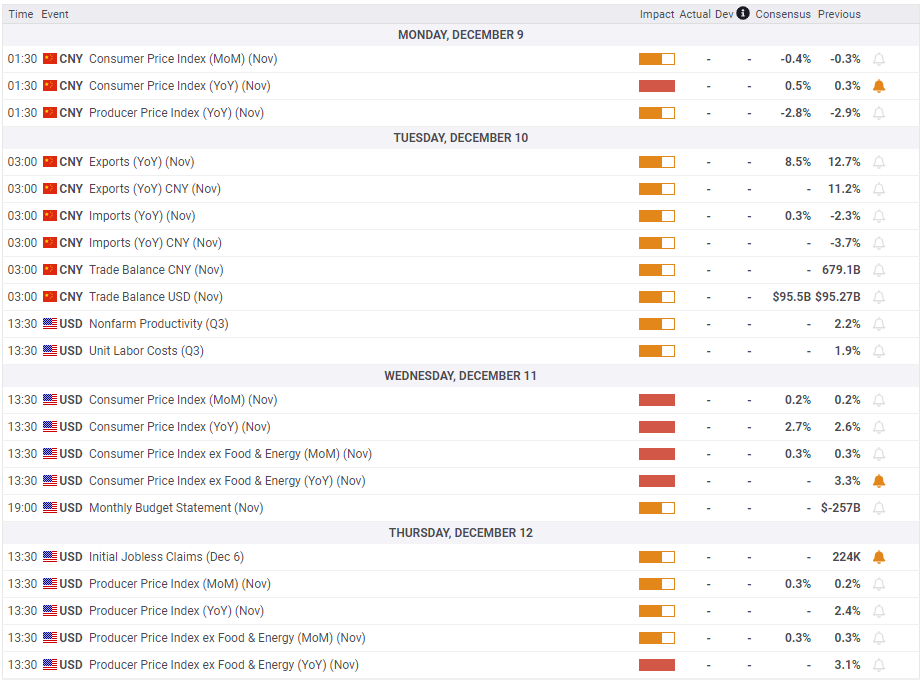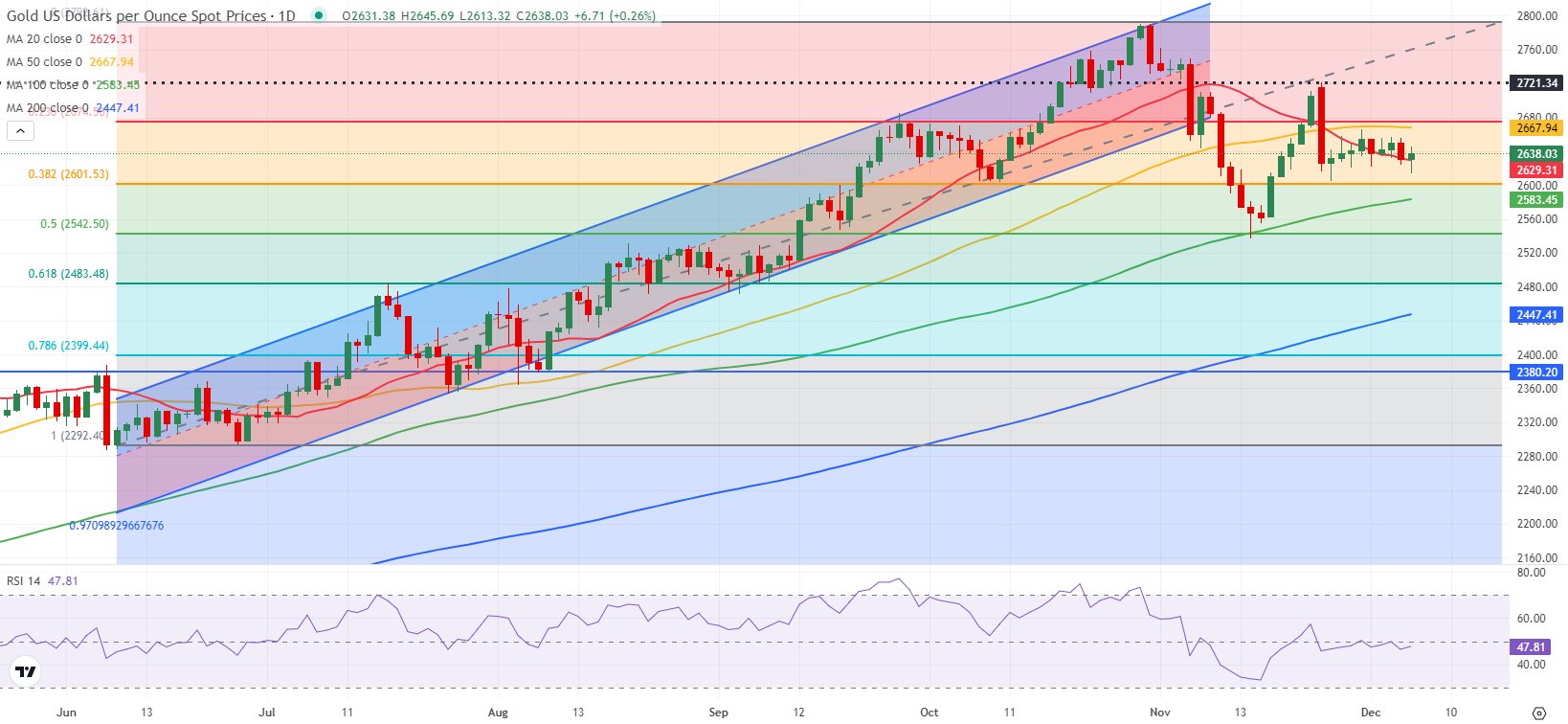- Gold struggled to make a decisive move in either direction this week.
- XAU/USD defines a consolidation range before the next breakout.
- US inflation and Chinese trade data could ramp up Gold’s volatility next week.
Gold (XAU/USD) opened in a calm manner on Monday and spent the rest of the week fluctuating in a narrow channel at around $2,650. Trade Balance data from China and November inflation figures from the United States could help XAU/USD break out of its trading range next week.
Gold suffers heavy losses on improving risk mood
Following the indecisive action seen in the second half of the previous week, Gold’s choppy action continued. In the absence of fresh developments surrounding geopolitics, XAU/USD ignored the US macroeconomic events and fluctuated in a tight channel in the first half of the week. Additionally, the benchmark 10-year US Treasury bond yield stabilized at around 4.2% after losing about 5% last week, making it even more difficult for Gold to find direction.
On Monday, the data from the US showed that the ISM Manufacturing Purchasing Managers Index (PMI) improved to 48.4 in November from 46.5 in October. The US Bureau of Labor Statistics reported on Tuesday that JOLTS Job Openings rose to 7.74 million in October from 7.37 in September.
While participating in a moderated discussion at the New York Times DealBook Summit on Wednesday, Federal Reserve (Fed) Chairman Jerome Powell reiterated that the US economy is in good shape. “The Fed is trying to be in a middle place where policy is less restrictive, so inflation can fall but not damage the labor market,” he added. Also on Wednesday, Automatic Data Processing (ADP) announced that employment in the private sector rose by 146,000 in November and the ISM reported that the Services PMI declined to 52.1 in November from 56 in October.
The US Bureau of Labor Statistics reported on Friday that Nonfarm Payrolls (NFP) rose by 227,000 in November. This reading followed the 36,000 increase recorded in October and surpassed the market expectation of 200,000. The underlying details of the data showed that the Unemployment Rate edged higher to 4.2%, while the annual wage inflation held steady at 4%. Despite the upbeat data, the USD struggled to gather strength, allowing XAU/USD to remain within its weekly range.
Assessing Gold’s recent valuation, “Gold's performance stemmed from a wild swing in investor positioning - morphing from underinvested at the start of the year to an extreme position size by US election night; alongside extreme physical market buying activity in the first half of the year, underscored by strong central bank increases,” said TD Securities Senior Commodity Strategist Daniel Ghali.
“Tailwinds from many of these underlying drivers have subsided. Following brief but significant liquidations, macro funds have reacquired a significant portion of their extreme position size, leading to renewed positioning vulnerabilities. And, this time around, a continued downtape,” Ghali added.
Gold investors shift focus to US, Chinese data
November Trade Balance data from China will be watched closely by market participants in the Asian session on Tuesday as investors grow increasingly concerned about the potential negative impact of US President-elect Donald Trump’s tariffs on the Chinese economic outlook. Hence, a noticeable increase in trade surplus could provide a short-term relief and help Gold edge higher with the immediate reaction.
On Wednesday, the US BLS will publish the Consumer Price Index (CPI) figures for November. On a monthly basis, the core CPI, which excludes volatile food and energy prices, is forecast to rise 0.3%, at the same pace it did in October. A reading of 0.5% or higher could revive fears over a pickup in inflation. In this scenario, the immediate reaction is likely to trigger a leg higher in US T-bond yields and weigh on Gold. On the flip side, a soft print of 0.3% or lower could have the opposite impact on XAU/USD’s action.
Since the Fed will be next week in the blackout period ahead of the December 17-18 policy meeting, investors will not have any comments from Fed officials to assess.
Gold technical outlook
The Relative Strength Index (RSI) indicator on the daily chart moves sideways near 50, reflecting the lack of directional momentum. On the upside, the Fibonacci 23.6% of the uptrend coming from June and the 50-day Simple Moving Average (SMA) form the first resistance area at $2,670.
In case Gold rises above this level and starts using it as support, technical buyers could show interest. In this scenario, $2,700 (static level, round level) could be seen as the next hurdle before $2,720 (static level) and $2,760 (static level).
Looking south, first support could be spotted at $2,600 (Fibonacci 38.2% retracement) ahead of $2,580 (100-day SMA) and $2,540 (Fibonacci 50% retracement).
Gold FAQs
Gold has played a key role in human’s history as it has been widely used as a store of value and medium of exchange. Currently, apart from its shine and usage for jewelry, the precious metal is widely seen as a safe-haven asset, meaning that it is considered a good investment during turbulent times. Gold is also widely seen as a hedge against inflation and against depreciating currencies as it doesn’t rely on any specific issuer or government.
Central banks are the biggest Gold holders. In their aim to support their currencies in turbulent times, central banks tend to diversify their reserves and buy Gold to improve the perceived strength of the economy and the currency. High Gold reserves can be a source of trust for a country’s solvency. Central banks added 1,136 tonnes of Gold worth around $70 billion to their reserves in 2022, according to data from the World Gold Council. This is the highest yearly purchase since records began. Central banks from emerging economies such as China, India and Turkey are quickly increasing their Gold reserves.
Gold has an inverse correlation with the US Dollar and US Treasuries, which are both major reserve and safe-haven assets. When the Dollar depreciates, Gold tends to rise, enabling investors and central banks to diversify their assets in turbulent times. Gold is also inversely correlated with risk assets. A rally in the stock market tends to weaken Gold price, while sell-offs in riskier markets tend to favor the precious metal.
The price can move due to a wide range of factors. Geopolitical instability or fears of a deep recession can quickly make Gold price escalate due to its safe-haven status. As a yield-less asset, Gold tends to rise with lower interest rates, while higher cost of money usually weighs down on the yellow metal. Still, most moves depend on how the US Dollar (USD) behaves as the asset is priced in dollars (XAU/USD). A strong Dollar tends to keep the price of Gold controlled, whereas a weaker Dollar is likely to push Gold prices up.
Information on these pages contains forward-looking statements that involve risks and uncertainties. Markets and instruments profiled on this page are for informational purposes only and should not in any way come across as a recommendation to buy or sell in these assets. You should do your own thorough research before making any investment decisions. FXStreet does not in any way guarantee that this information is free from mistakes, errors, or material misstatements. It also does not guarantee that this information is of a timely nature. Investing in Open Markets involves a great deal of risk, including the loss of all or a portion of your investment, as well as emotional distress. All risks, losses and costs associated with investing, including total loss of principal, are your responsibility. The views and opinions expressed in this article are those of the authors and do not necessarily reflect the official policy or position of FXStreet nor its advertisers. The author will not be held responsible for information that is found at the end of links posted on this page.
If not otherwise explicitly mentioned in the body of the article, at the time of writing, the author has no position in any stock mentioned in this article and no business relationship with any company mentioned. The author has not received compensation for writing this article, other than from FXStreet.
FXStreet and the author do not provide personalized recommendations. The author makes no representations as to the accuracy, completeness, or suitability of this information. FXStreet and the author will not be liable for any errors, omissions or any losses, injuries or damages arising from this information and its display or use. Errors and omissions excepted.
The author and FXStreet are not registered investment advisors and nothing in this article is intended to be investment advice.
Recommended Content
Editors’ Picks

AUD/USD ticks lower toward 0.6200 after Australian Nov inflation data
AUD/USD remains pressured toward 0.6200 following the release of Australian consumer inflation figures, which showed a slowing in the trimmed mean annual CPI , boosting the odds for an April RBA rate cut. Meanwhile, US-China trade war fears and a softer risk tone add to the weight on the pair.

USD/JPY steadies at around 158.00, Fed Minutes awaited
USD/JPY holds steady at atound the 158.00 mark early Wednesday amid uncertainty over further BoJ rate hikes. Further, the Fed's hawkish shift, the recent surge in the US bond yields and a bullish US Dollar support the currency pair, though Trump trade risks cap gains. US ADP data and Fed Minutes eyed.

Gold consolidates near $2,650 amid mixed cues; looks to Fed Minutes
Gold price stabilizes near $2,650 after the pullback from the $2,665 barrier as concerns about Trump's tariff plans and geopolitical risks support the safe-haven bullion. That said, diminishing odds for further Fed rate cuts and elevated US Treasury bond yields-led US Dollar strength weigh on Gold price ahead of Fed Minutes.

Crypto market surged to $3.9 trillion record market cap as Solana's revenue plunged in December: Binance
In a report on Monday, Binance Research stated that the crypto market reached a market capitalization milestone of $3.9 trillion in December. The researchers suggest anticipation surrounding Donald Trump's upcoming pro-crypto administration could stretch the bullish momentum in the coming weeks.

Five fundamentals for the week: Nonfarm Payrolls to keep traders on edge in first full week of 2025 Premium
Did the US economy enjoy a strong finish to 2024? That is the question in the first full week of trading in 2025. The all-important NFP stand out, but a look at the Federal Reserve and the Chinese economy is also of interest.

Best Forex Brokers with Low Spreads
VERIFIED Low spreads are crucial for reducing trading costs. Explore top Forex brokers offering competitive spreads and high leverage. Compare options for EUR/USD, GBP/USD, USD/JPY, and Gold.

